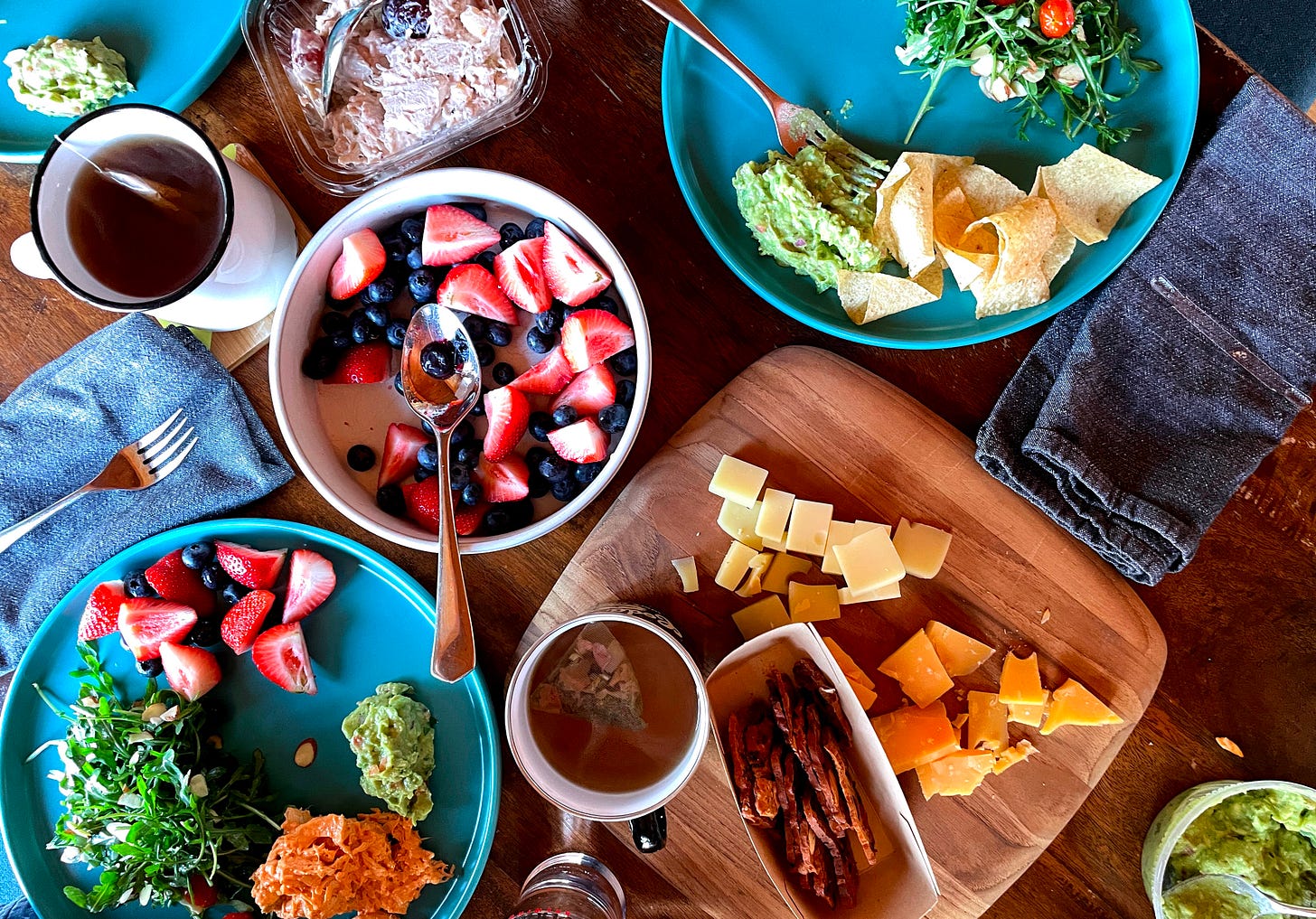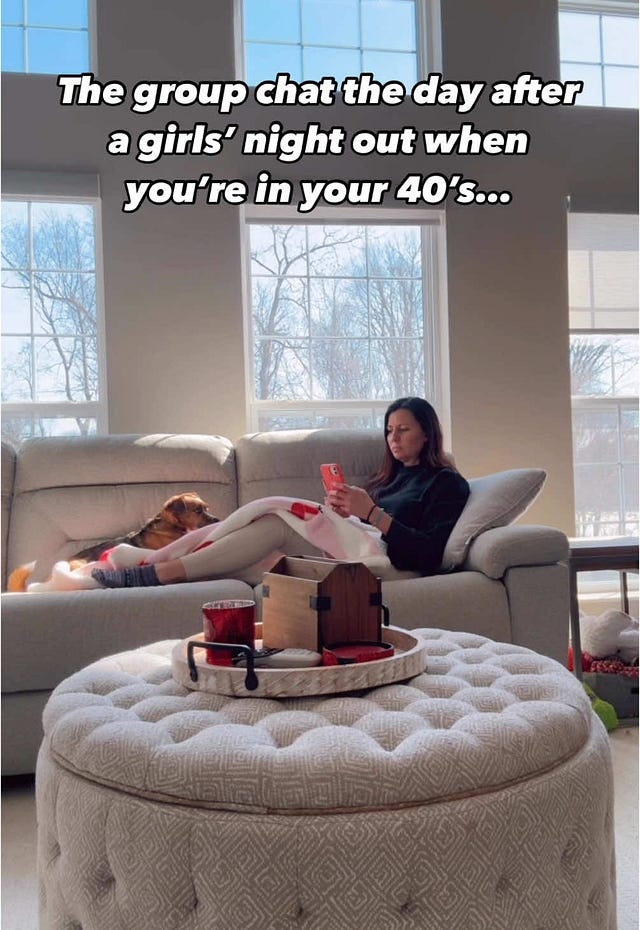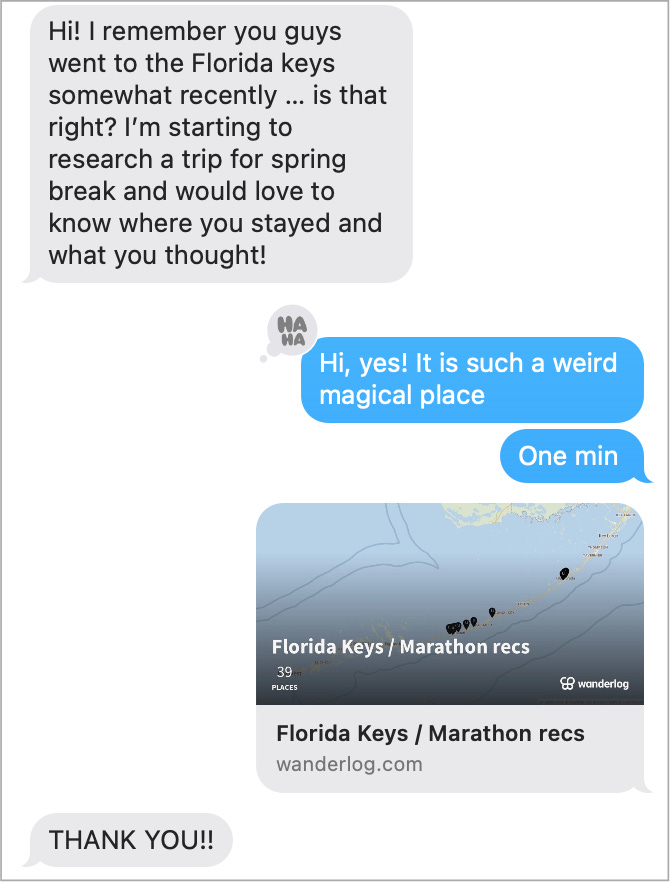This post is part of my “Ask An Expert” series, which features locals with a niche expertise. What’s yours? Email me at kaylakaplowitz@substack.com with your idea!
This is part 2 of a two-part series on How to Make and Maintain Friends as a Parent. If you missed Part 1, you can read the full piece here.
Last week’s live with Pound Ridge mom and leadership coach Kaylin Aarts was so fun. For all you “newborn” parents or upperclassmen moms & dads out there hoping to build (or re-build) your local friend network, we hope you learned something.
Today, we’re talking about the art of maintaining friendships.
When I was a kid, I always remember being around family friends. Camping trips and group vacations at Deep Creek Lake and Ocean City. Last-minute pool get-togethers at our neighbor’s. Friday driveway hangs. Stopping by my mom’s friends’ houses just to say hi. 4th of July picnics. The annual neighborhood Christmas party.
When I became a parent, I had this nagging feeling that my mom and dad were just better at this than I was. How did they make all this happen? How do I do the same?
But that’s just it: Great friendships in this stage of life don’t just happen. Behind all of these great childhood memories is intentionality. Kinkeeping work.
To my mom and all her friends back in the 90s, that meant organizing and coordinating regular hangs, annual traditions and last-minute get-togethers. It meant making the time to send the cards, drop off the casseroles, and watch each other’s kids in a pinch. It’s necessary work.
A few weeks ago, a friend reminded me that before long, our kids will be out of the house. I know, it’s a depressing thought to kick off your Monday, but here we are. The point is there’s never a better time than now to invest in local friendships.
Today, Kaylin and I structured our discussion today around practical tips and research-backed advice that can help you in your own quest to be a better friend and kinkeeper.
Below are just snippets. Watch the video for our full conversation!
Remember things.
KAYLIN:
Remember your moments. Like when you had a blast together. Or when they showed up for you. When a memory pops up in iCal or Google Photos, use it to reach out. I think photo flashbacks are a cue from the universe to do just that.
Remember to check-in with friends. And not just when they’re going through it; it’s the weeks and months afterwards that matter most. After the first wave of support quiets down, grief can feel even more isolating. My go-to is: “No need to respond if you're not up for it, but I'm here—to talk, grab a coffee, or just have someone sit with you.” It gives them space to respond (or not) in a way that feels right for them.
KAYLA: I sometimes have a terrible memory, which I hate. When I was working in PR, I created systems to ensure I’d maintain a great relationship with journalists I’d regularly interact with. Today, I use these in my “friendship work” because if I forget basic things, I may never turn an acquaintance into a real friend. Like:
Remember things you talked about. That way, the next time you see them you can follow-up. (How was Disney? I tried that restaurant you loved!). I use my Evernote app for this.
Remember their kids’ names. I always feel like such an asshole when I can’t remember which kid belongs to which parent. So I started saving my kid’s class rosters as a shortcut in my phone so I can discreetly pull it up at school events. I also save kids’ names & ages into a friend’s Contact card + whatever else I may need to know to jog my memory. (e.g., they also belong to the town pool, they also grew up in PA, etc).
Remember birthdays. I put friends’ birthdays as a recurring event in my calendar and try to send a text the morning-of. If I wait, I’ll never do it. I put in kids’ birthdays too.
Remember important dates. Put these things in your calendar when a friend tells you something, and set a reminder to check in. (e.g., the day their baby is starting daycare, etc.). I often use the “Schedule Send” iMessage feature so I don’t have to think about it. Also, this box of cards is so handy – you’ll always have a “Get Well,” “Congrats,” or “Happy Birthday” card ready to send.
Follow up.
KAYLIN:
Follow up and follow through. This is my love language. My advice is to make the next date while you’re together vs. sitting on it. This way, it reduces the chance that one person leaves feeling the weight of accountability (e.g., Who reaches out to who?) Deciding the when and where of it all in the moment makes it a co-created mutually-invested experience and gives you both something to look forward to.
Adaptive leadership. In my work, adaptive leadership is knowing when to support other good leaders and empowering them to step up. In friendships, the balance often shifts, which is what you want. Sometimes you’re the supporter, sometimes you need support. Being attuned to these shifts keeps the friendship healthy.
Regular “roll calls.” My college friends do a semi-regular and spontaneous “roll call” on our group chat. Usually it’s just asking everyone to send a photo and message of what they’re up to in that moment. A wedding in Hawaii, or at the dentist; we love to see it. Sometimes throw in prompts that everyone has to answer. We’re all spread out, so it’s been a great way to stay in touch and get a snapshot into each other’s lives.
KAYLA:
I place such a high value on follow-up (and follow-through) with friends, so I try to maintain that standard for myself.
Reach out when you’re thinking of a friend. “I tend to send texts or make calls to friends when they’re on my mind, in that moment, just to let them know I’m thinking of them,” my friend Suzy recently told me. “And that simple act just deepens the connection every time.”
Immediately follow up after a get-together. Don’t wait. The soup recipe you mentioned, the podcast, the event you want to check out together, etc. I do that in my car or as soon as I get home when it’s still fresh in my mind.
Be a resource.
KAYLIN:
Recommendations. Be like Kramer. If you’ve got a recommendation on where to go for the freshest fruit in town, don’t gate-keep it. And know your friend’s niche expertise, too. People love to be a resource. I know I do.
Be a matchmaker. We all love connecting good people with other good people. I try to create sparks of that on a regular basis. I love when a college friend tells me something about a local friend I told them to follow on Instagram (e.g., “I saw Claire is speaking on that panel. That’s so great! Happy for her.”) Network for your friends. Connect them.
Understand your friends’ “user manuals.” When I work with teams—especially new teams—I ask them to fill out a user manual. Questions like: What does it look like when I’m close to burnout? What is most draining/energizing for me? Do I like phone calls or emails? Imagine if you and your friends proactively shared this info. with each other. You have a lot more data to work with, right? It’s all relevant.
KAYLA: I do a few things to keep my recommendations organized and at-the-ready:
Babysitter recommendations. Figure out a filing system in your Contacts app so you can pull things quickly. Every time we find a good sitter, I put “Babysitter” in the job title. So, when a friend is in desperate need of a good sitter, I quickly search in my contacts and 10 names pop up. BOOM. Here you go, my dear.
Vacation recommendations. I LOVE the Wanderlog app. Anytime we go somewhere new, I use this to save where we should go, eat, or stay. At the end of every trip, I try to take a few minutes to update the list so that if a friend needs a recommendation, I have my “guides” at the ready and can drop them a link.
Establish regularity.
KAYLIN:
Rhythms, repetitive proximity are key. In the summer I like to do “join if you can” meetups, like Wednesday summer porch nights when my kids are in bed.
Establish rules for group decisions. Deciding how to decide (autocratic, consensus, democratic, delegation, consultative, stochastic) is key. Applies to major decisions like budget & locale for an annual girls trip, and minor ones like group birthday gifts for friends.
KAYLA: I heard on a podcast recently that the friendship-building years peaks at about age 25—I think the “cult of busyness” has a lot to do with this. We are all busy. I get it. So, I go for things that are relatively low-lift:
Join-if-you-can meetups. At the beginning of this school year, a few friends decided we’d try to walk around the lake every Wednesday morning. Sometimes it’s all 4 of us, sometimes it’s just 2 + a sniffly kiddo in a stroller. The point is that it’s regular. If you can make it great. But if not, no problem. No endless texts about scheduling to see when everyone’s next available.
Rotating themed nights. A group of friends and I used to do pizza nights quite regularly on Fridays. We’d rotate hosting responsibilities, order a bunch of pizzas, and let the kids run around. I’ve also read about cookbook clubs and stoop coffee hangs that don’t require a stoop!. Oh, and Kaylin you sent me this idea: a “Friendship Joy Train,” which sounds weird, but 100% speaks to my Virgo introvert/extrovert heart.
Prioritize adult-only get-togethers. My friend Suzy told me recently she and her partner are being more intentional about this. “This is the first time in our parenting/life journey (11 years) where we’re actively seeking this out,” she said. “It’s so impactful in growing friendships in a more personal way.”

Don’t take it personally.
KAYLA:
Keep sending the invites. I’ve had friends specifically tell me to not stop inviting them to things, even if they turned me down 5 times. So I started to say the same to others. As a parent, our schedules literally change every season. Kids get sick, they’re doing new extracurriculars, or you just don’t feel like leaving your house. Don’t give up: if you know in your gut that there’s a connection, keep throwing the invites out there. (Use The Plan for ideas 😉)
KAYLIN:
So important! I tend to be a homebody and not always the first one to say “yes” to adventure or a night out, but it means the world to me to be invited.
Listen.
KAYLIN:
Be intentional about listening. In my coaching work, I often talk about the “3 levels of listening.” It’s all about how you show up and give focus to your friends and family in conversation. If you’re cognizant of these, it’ll help you be more present in every conversation with a friend, which is exactly how you strengthen any relationship.
Level 1: Internal listening where your attention is on your own thoughts, feelings, and interpretations.
Level 2: Focused listening. Like a laser, where you are completely focused on the other person.
Level 3: Global listening, which is a soft, receptive focus that encompasses everything around you, your senses, and your environment.
Be vulnerable.
KAYLIN:
Get in the trenches. It takes bravery to go deep with a friend. Don’t shy away from it.
Consider psychological safety. This is a huge buzzword in the workplace. It’s how individuals perceive how comfortable they are in their environment to express their thoughts, opinions, concerns, and mistakes without fear of negative consequences. Notice this in your own friendships. When a friend wants to vent, ask them first if they want you to just listen, or if they’re actually looking for your advice. There’s a difference.
KAYLA:
Send voice notes. There’s something so lovely about hearing a friend‘s voice. It’s like the feeling you got in the 90s when you got a voicemail on your answering machine from someone. The best. (But keep ‘em short!)
Know what you can tease your friends about. This is my love language. I’m completely Type A, for example, and love to be teased about this. I showed up to a friend’s game night with a bag of pens labeled “pens” and will forever be dragged for this. I love it.
Be open.
KAYLIN:
Don’t assume that someone wouldn’t want to be friends. Different walks of life, different ages, doesn’t matter. Don’t shortchange the potential for a relationship if you’re really clicking with someone.
Don’t discount older friends. When you leave your echo-chamber of parent friends who are in the same phase of parenthood, it can be amazing. Making friends with people who are older than you can give you perspective and help you see things through a new lens.
And that’s it! Thanks to:
Kaylin Aarts, a leadership coach and organizational development consultant who helps individuals and teams cultivate intention, action, and fulfillment in their work. Through her coaching and consulting, she empowers leaders to step into their potential and build stronger, more purpose-driven organizations. She and her husband live in Pound Ridge with their two kids and Bernedoodle, Bru. You can find her online at @kaylinaarts and kaylinaarts.com.
RESOURCES
Click here for a list of resources from our previous post. And here’s a few more. Send me more if you have them!
Books / newsletters / podcast recs
We Should Get Together, by Katie Salisbury – This one was hailed as “the ultimate playbook for making new friendships and strengthening old ones.” »
Close Friends (coming in 2026) – Anne Helen Petersen is the force behind Culture Study, my favorite podcast and Substack. For her 5th book, she’s writing about friendship, community, the cult of individualism, and how we got here. I can’t WAIT. »
Interview with author Grace Bonney on Call Your Girlfriend – I found this episode so refreshing. It’s all about Bonney’s research and book about the value of intergenerational friendships. »
Aviva Romm’s interview with journalist/author Anna Goldfarb – A friend sent me this podcast episode recently and I really liked it. They dive into modern friendships: How to think of them and how they change over time. I especially loved they part when they spoke about res-setting a friendship vs. ending it altogether because of a disagreement. I recommend. »















Share this post